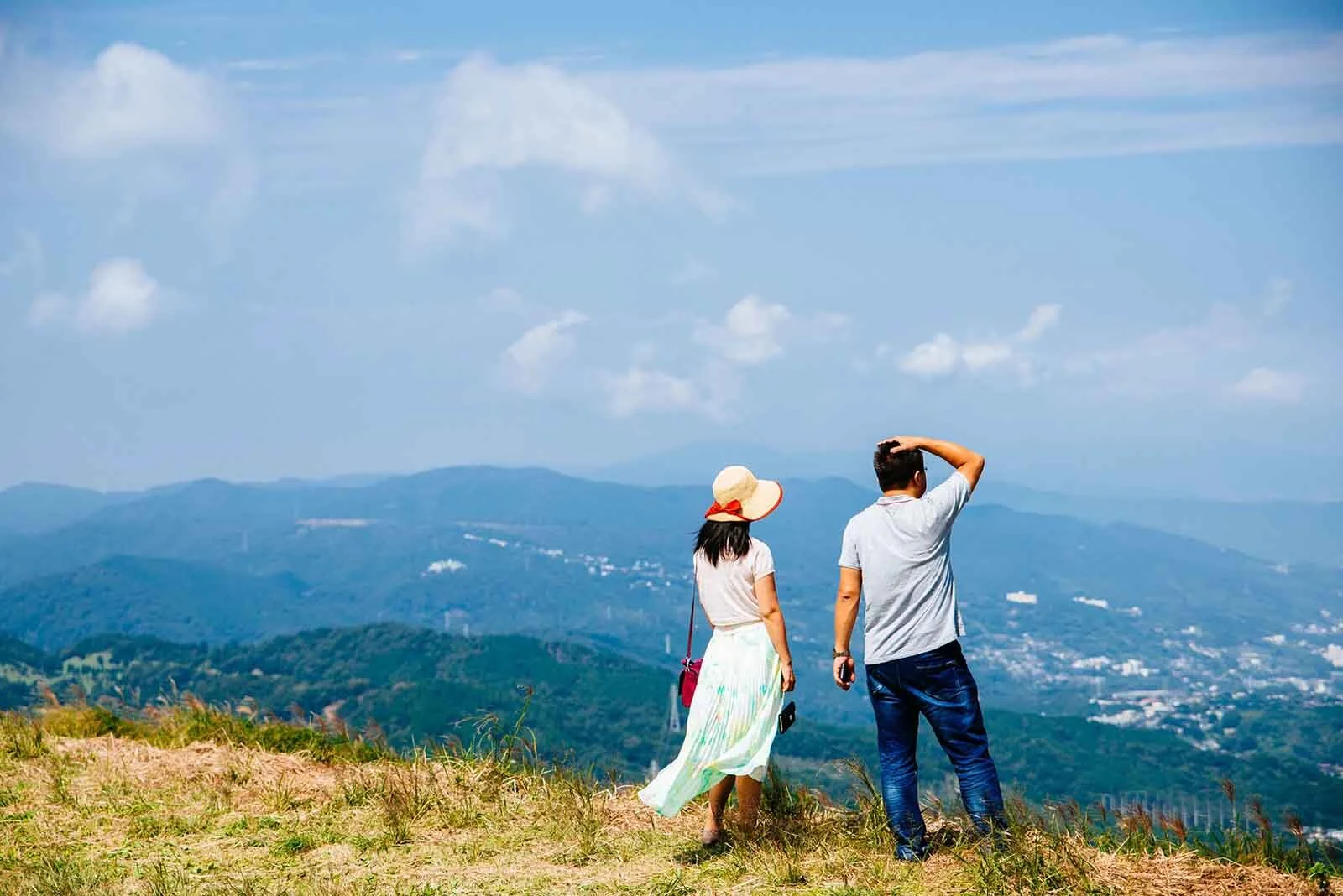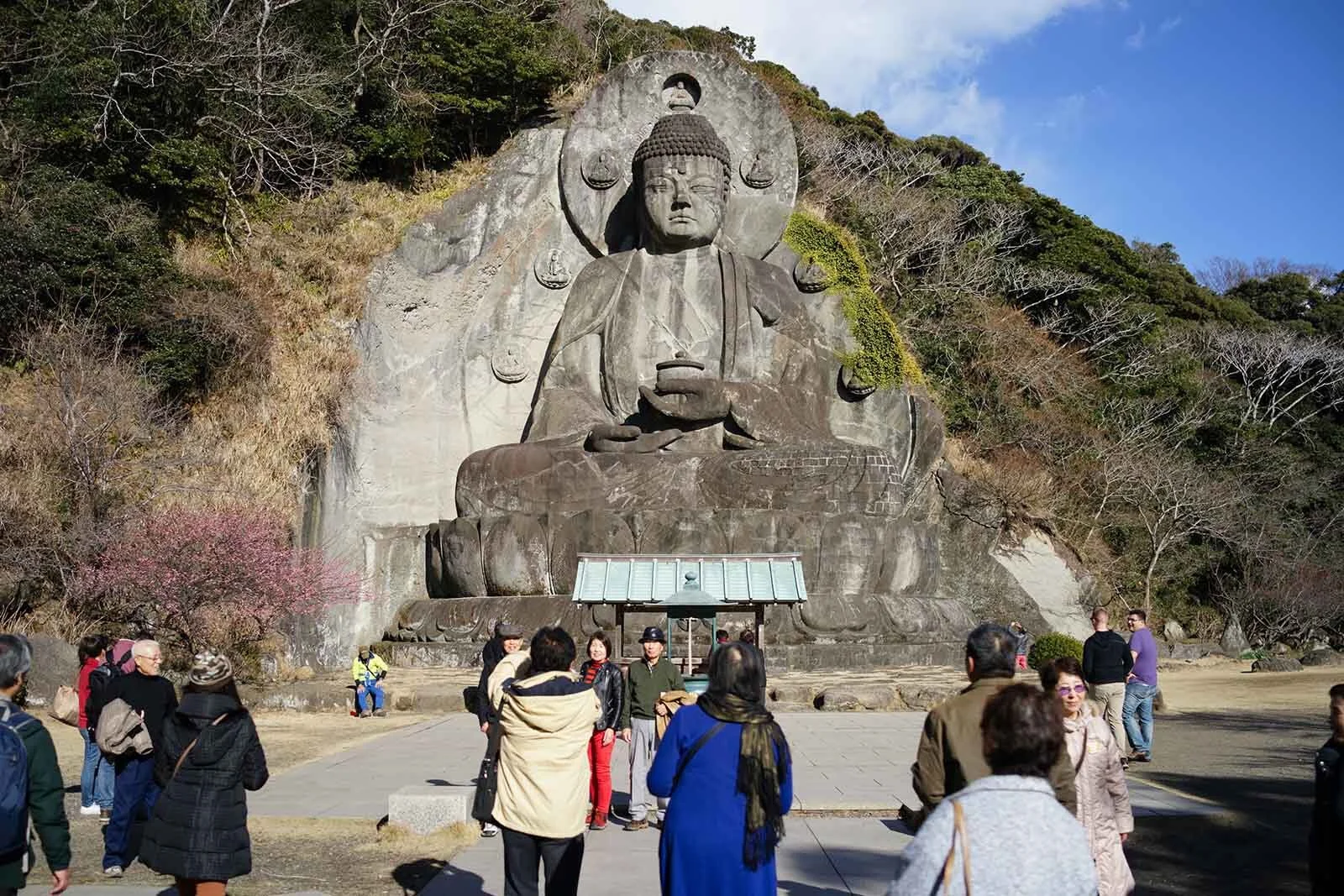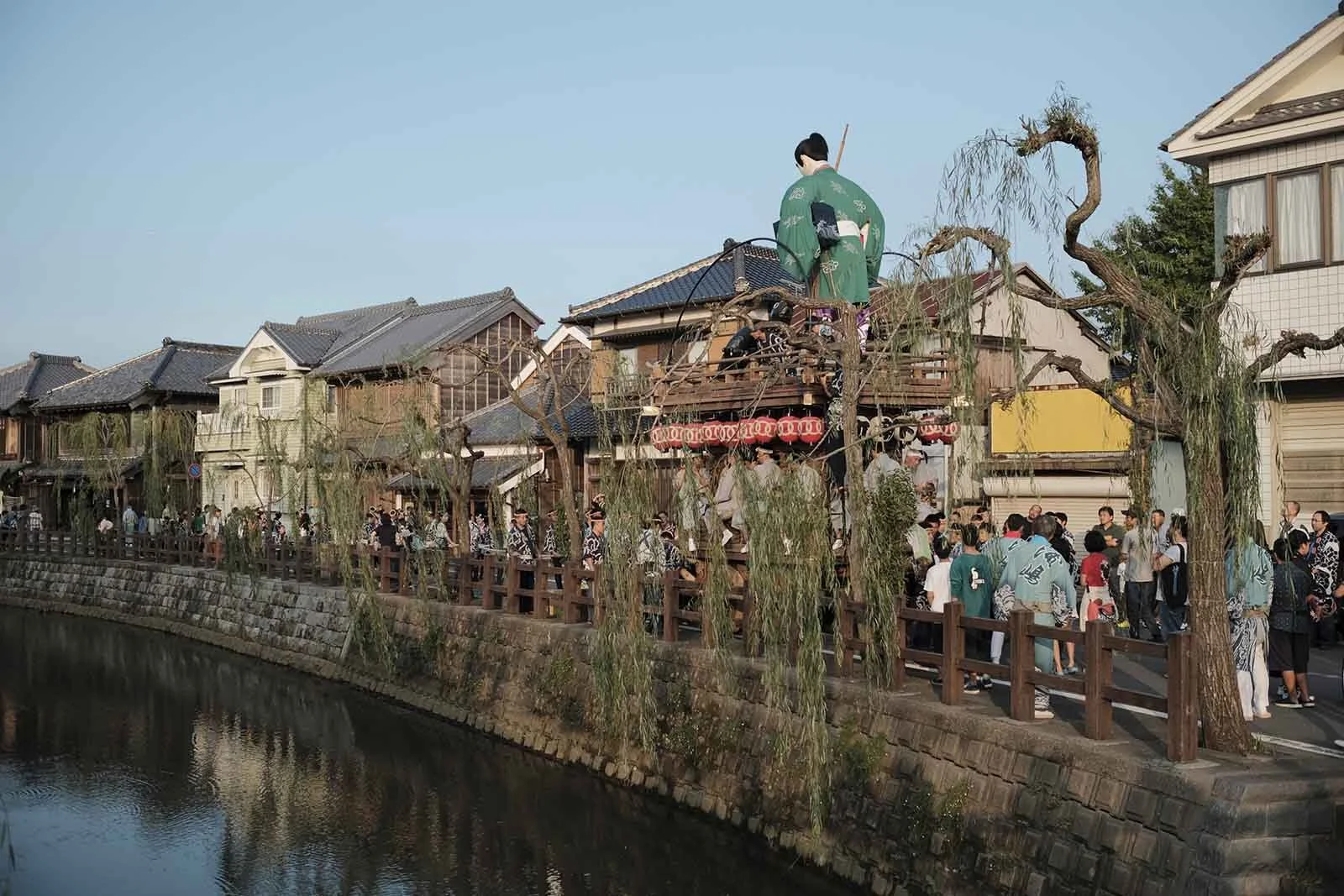In the second and final part of this blog post, I’ll introduce a few more of my favorite daytrip destinations near Tokyo. All of these are places that I have returned to multiple times, thanks to their endless photographic opportunities. If you haven’t already, I recommend that you start with the first part of this series.
The Izu Peninsula
This peninsula, located on the border of Kanagawa and Shizuoka prefectures, is full of worthwhile destinations. Being home to several bubble-era resort towns, many places certainly has seen better days, as the number of tourists finding their way there these days, probably peaked sometime in the 1980s. Trains traverse its eastern coast, where major cities such as Atami and Ito are located. On the southern tip lies Shimoda, home to some of the prettiest sandy beaches in the greater Tokyo region. The western coast of the peninsula is less developed and lacks train access. For those willing to rent a car though, its also worth exploring, thanks to the dramatic and rugged landscapes, of which Dogashima is perhaps the most well-known and accessible part.
While it’s certainly possible to visit the Izu Peninsula in a day trip, I highly recommend that you spend one night here, to get the most out the long-ish ride it took you to get there.
How to get to the Izu Peninsula: Take the JR Tokaido Line, or the Tokaido Shinkansen, to Atami, where you change to the JR Ito Line. Further south, a company called Izukyuu Railways takes over, running the final stretch of railroad down to Shimoda. A handful of express trains, called Odoriko, runs all the way from Tokyo Station to Shimoda without the need of making any transfers. The entire trip takes 160 minutes and cost 6000 JPY.
If you are travelling from Tokyo, the JR Wide Pass is recommended. The pass will give you unlimited train rides in the entire Kanto Region for three consecutive days, for a price lower than the round trip cost of getting to Shimoda. Please note that the JR Wide Pass is only available to foreign passport holders, but unlike the Japan Rail Pass, even foreign citizens living permanently in Japan are allowed to use the JR Wide Pass.
Boso Peninsula & Mt. Nokogiriyama
This peninsula makes up the eastern part of Tokyo Bay and is entirely located in Chiba prefecture. While it doesn’t have as much going for it as the Izu Peninsula, it’s still worth a visit, particularly for those of you looking for a more rural and quiet day trip destination. My personal favourite spot is the mountain Nokogiriyama, as the light hike up to its 330 m high peak will give you some truly spectacular views of the entire Tokyo bay. On bright days, even Yokohama and Tokyo can be spotted in the distance from the peak.
The mountain is also home to a Zen Buddhist temple with a history that dates back more than 1300 years. Several places of worship are located on the mountain, some of the most noteworthy are giant buddha statues carved out of the mountain itself.
Getting to the Boso Peninsula: Thanks to its relative proximity to Tokyo, and the significant number of inhabitants commuting to the city daily, several train lines are serving the Boso Peninsula. If you’re heading to Nokogiriyama, you’ll be best served by the JR Uchibo Line, which makes a loop around the entire peninsula.
There’s also a ferry service between Kanaya, close to the mountain, and Kurihama on the Miura Peninsula. If you are travelling from Kanagawa, this might be a quicker route than taking the train.
Sawara
On the topic of Chiba, another destination that deserves to be mentioned, is the town of Sawara, home to a picturesque city with rows of traditional wooden houses built next to a small canal. It’s often referred to as “Ko-Edo”, or Small Edo, where Edo is referring to the old name of Tokyo.
Sawara is also home to the Sawara Matsuri, where massive floats depicting historical and legendary warriors are pulled through the city. I visited the festival once, on assignment for the magazine Discover Japan, and it was indeed an extraordinary experience. The festival takes place two times every year, in July and October. A few years ago, the festival became a UNESCO recognized intangible cultural asset of Japan. You can learn more about the festival, including upcoming dates, on the official website of the city.
How to get to Sawara: The city is located northeast of Narita Airport, and connected to Tokyo via the JR Narita Line. The entire trip from Tokyo Station takes approximately two hours and will set you back 1690 JPY. A quicker option is to take a highway bus, which will get you there in just one hour and 20 minutes, for roughly the same cost. The official website has useful information about the various options.
Kamakura
Kamakura definitely ranks among one of the most popular day trip destinations from Tokyo, and it does so for a good reason. Located a mere hour from central Tokyo, and with a slew of attractions ranging from sandy beaches to temples, bamboo groves and several scenic hiking trails. I plan to write a more comprehensive guide to the area shortly. But there are already plenty of useful resources around, including the Nightlife Guide to Kamakura that I wrote last year.
Donny Kimball has also written an excellent guide to Kamakura outlining most of the most noteworthy spots in the region
How to get to Kamakura: I highly recommend getting the Enoshima Kamakura Freepass, and make a stop in Enoshima while you’re at it. The pass costs 1520 JPY and will give you the round trip via Odakyu Line from Shinjuku, as well as unlimited rides on the charming Enoden local train, connecting Enoshima to Kamakura.
If you’re only planning to visit Kamakura, however, travelling via JR is quicker. JR also sells a pass that gives you free rides on the JR lines in the region, as well as the Enoden and Shonan monorail. Still, for some reason, it doesn’t cover the journey between Tokyo and Fujisawa, so in the end, it will come out quite a bit more expensive than if you travel with Odakyu.
Enoshima
Enoshima, while being located near Kamakura, is also what I would consider worthy of a day trip in itself, as there’s just so much to see and do on this charming little island. It’s undoubtedly another destination I will get back to in a more comprehensive blog post soon. Charming shops, beautiful shrines, scenic views of Sagami Bay and Mt. Fuji in the distance, as well as plenty of good restaurants serving delicious seafood, are some of the reasons why this is one of my most frequent escapes from central Tokyo.
The only thing any prospective visitor needs to be aware of is that Enoshima can get really crowded, particularly on weekends and national holidays. My best advice is to get there as early as possible, preferably on a weekday.
How to get to Enoshima: The Odakyu Enoshima pass, mentioned above, is the best option.
Hakone
Hakone is another place that has seen a massive surge in tourists in recent years. The area used to be a relatively quiet resort destination, where primarily Japanese people used to come to spend a weekend soaking up at an expensive onsen hotel. But because of the tourism boom that has taken place in the last ten years or so, the area has unfortunately transformed, somewhat for the worse. These days, parts of Hakone are full with busloads of tourists, and the public transportation in the area is often unpleasantly crowded.
That being said, Hakone still has a lot going for it, and if you are avoiding the peak tourism seasons, you should be able to have a great time there. The cable car ride over the volcanic landscapes in the area is spectacular, and there are plenty of spots worth visiting around the beautiful Lake Ashi (Ashinoko).
One of my personal favourite ways to end the day around here is by soaking my feet in the hot footbath at the cafe Bakery and Table while watching the sunset behind mt. Fuji reflected in the said lake.
How to get to Hakone: I highly recommend using one of the various passes offered by Odakyu, that will cover most of your transportation needs in the area. A two-day pass, originating in Shinjuku, will set you back 5700 JPY. Pay a little bit extra if you want a more comfortable seat on one of their “Romancecar” express trains.
Yokohama
Tokyo’s neighbouring city also makes for a great day trip destination. As Yokohama is the second-largest city in Japan, there’s no shortage of things to see and do here, and going through it all will be beyond the scope of this post. But here are three of my favourite things to do in Yokohama:
Explore the waterfront area, and the futuristic Minato Mirai 21 district. This part of Yokohama is full of great photographic subjects, ranging from interesting architecture to scenic urban landscapes. It’s particularly striking at night, or even better during blue hour.
Go bar hopping in Nogecho. One of Yokohama’s most charming districts for food and drinks, and located within walking distance from the waterfront area and Sakuragicho Station. Also great for street photography. I’ve written a comprehensive guide to the area that you can find here: https://noctive.jp/article/NTT-nt-0043-en
Yokohama Chinatown is another area that is great for street photography, due to its mix of quirky buildings, shop-lined streets and bustling atmosphere. Again, it’s an area that looks its best at night, but it’s worth experiencing anytime.
How to get to, and around Yokohama: If you’re travelling from Tokyo, you can take either the Tokyu Toyoko Line from Shibuya or one of the many JR lines connecting the two cities. Expect the ride to take roughly 30 minutes, depending on where you get on and off. If you’re travelling from Shibuya, the Tokyu Line Minatomirai Pass is useful, as it will give you unlimited rides on the Minato Mirai Line, as well as a roundtrip between Shibuya and Yokohama station on the Tokyu Toyoko Line. In 2020, the price of the ticket is 870 JPY.
Kawagoe
Kawagoe is another town close to Tokyo, that is known for its atmosphere akin to the old days. The streets are full of traditional Japanese warehouses, or “Kura”, and there are also plenty of beautiful temples and shrines located in and around the city. Not far from the centre of Kawagoe, you’ll find Kashiya Yokocho, or “Candy Alley”, a small street where a dozen or so sell traditional Japanese sweets and candy. It’s perhaps one of the most visually appealing areas of the town, but also one of the most crowded.
Even though it hurts to recommend something as commercial as a Starbucks, it’s difficult not to, as the one you’ll find in central Kawagoe is perhaps the most beautiful iteration of this chain cafe that I’ve ever been to. The purpose-made building is a blend of traditional and modern Japanese architecture, and the interior is also decorated with various art pieces inspired by traditional Japan. There’s also a traditional Japanese garden where you can sit and sip your coffee while enjoying the ambience. Your average Starbucks this is not.
How to get to Kawagoe: JR, Seibu and Tobu are train companies all connecting Tokyo and Kawagoe. The quickest option is to hop on the Tobu Tojo Line from Ikebukuro, a ride that takes 30 minutes and will cost 480 JPY.
Tama River
This river separates Tokyo Metropolis from Kanagawa Prefecture and is a great place to go if you are craving a relaxing stroll or bike ride. Despite it being located just 10 minutes by train from Shibuya, the atmosphere along the river is tranquil and relaxing, and It’s a place I keep coming back to again and again.
An excellent place to start is at Futako Tamagawa Station, a part of town that has recently seen massive redevelopment and is today home to many high-rise buildings and a few attractive shopping facilities. My personal favourite is Tsutaya Kaden, a bookstore that also houses various home electronics departments, as well as several cafés. From Futako Tamagawa, head down to Hyogojima, a park next to the river. If you’re feeling for a longer walk, I recommend following the river for an hour or so, until you reach Izumi Tamagawa station on the Odakyu Line. On clear days, the mountain ranges that make up the western border can be seen in their entirety from here, and you’ll also get plenty of opportunities to capture the sunset behind mt. Fuji, if you time your visit right.
How to get to Tama River: This river is long, and many train lines cross it. But for the places mentioned in this post, you’ll be best served by taking the Tokyu Den-En-Toshi-Line from Shibuya to Futako-Tamagawa station, a ride that takes 10 minutes and cost 200 JPY.
Showa Kinen Koen
This park is located in Tachikawa, in the far western part of Tokyo, and another destination worthy of a day trip, thanks to its vast flower fields and ample recreational spaces. It’s a total of 160 hectares in size, making it one of the biggest parks in the Tokyo region. Unsurprisingly, it’s a popular spot for Hanami picnics during the cherry blossom season. Still, personally, I think it’s more interesting to come here during autumn when the colourful foilage makes for many great photographic opportunities. Due to the heat island effect of Tokyo, autumn colours tend to arrive at this park a week or two earlier than in downtown Tokyo.
There’s also a charming bonsai museum, in the park, as well as an artificial lake and a folk house village. In short, it’s a great place if you want to stroll around with your camera surrounded by lush greenery with lots of photographic opportunities.
How to get to Showa Kien Koen: Easy, Just take the JR Chuo Line from either Tokyo Station or Shinjuku, and get off at Tachikawa station or Nishi-Tachikawa station. The ride takes about 30 minutes and costs 650 JPY.








